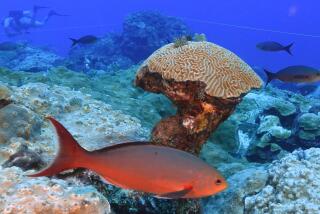Winter chill takes toll on Florida Keys coral
- Share via
Reporting from Miami — January’s bitter cold may have wiped out many of the shallow-water corals in the Florida Keys.
Scientists have only begun assessments, but initial reports are bleak. The damage could extend from Key Largo through the Dry Tortugas islands west of Key West, a vast expanse that covers some of the prettiest and healthiest reefs in North America.
Given the depth and duration of the frigid weather, Meaghan Johnson, marine science coordinator for the Nature Conservancy, expected to see losses. But she was stunned by the devastation when she joined a dive team surveying reefs in the Florida Keys National Marine Sanctuary. The divers were looking for “bleaching,” a telltale indicator of temperature stress in corals.
Star and brain corals, large species that can take hundreds of years to grow, were as white and lifeless as bones, frozen to death, she said. Dead sea turtles, eels and parrotfish also littered the bottom.
“Corals didn’t even have a chance to bleach. They just went straight to dead,” Johnson said. “It’s really ecosystem-wide mortality.”
The record chill that gripped South Florida for two weeks took a heavy toll on wildlife -- particularly marine life.
The Florida Fish and Wildlife Conservation Commission reported that a record number of endangered manatees had succumbed to the cold this year -- 77, according to a preliminary review. The previous record, 56, was set last year.
The warm Gulf Stream is believed to have protected deeper areas, but shallower reefs took a serious, perhaps unprecedented, hit, said Billy Causey of the National Oceanic and Atmospheric Administration.
Coral-bleaching has struck the Keys in the past, most recently twice in the 1990s, preceding a die-off that claimed 30% of the reef tract. But those events, along with others that have hit reefs around the world, have usually been triggered by water hotter than corals typically tolerate.
Healthy corals depend on a symbiotic relationship between polyps, the living tissues that slowly build the hard outer skeletons that give species distinctive shapes, and algae called zooxanthellae that give corals their vibrant colors. But when ocean temperatures are too hot or cold for too long, corals shed that algae, turning dull or a bleached bone-white.
The effect usually doesn’t kill coral immediately but can weaken it, slowing growth and leaving reefs more vulnerable to diseases, pollution and damage from boaters and divers.
Cold-water bleaching last occurred in 1977, when it snowed in Miami, killing hundreds of acres of staghorn and elkhorn corals across the Keys. Neither species has recovered, and in 2006, both became the first corals to be listed as threatened under the federal Endangered Species Act.
This year’s big chill, Causey said, shapes up worse.
“They were exposed to temperatures much colder, that went on longer, than what they were exposed to three decades ago,” he said.
Typical winter lows in-shore hover in the mid- to high 60s in the Keys. During this cold spell, a Key Largo reef monitor recorded 52.
Morgan writes for the Miami Herald.
More to Read
Sign up for Essential California
The most important California stories and recommendations in your inbox every morning.
You may occasionally receive promotional content from the Los Angeles Times.










